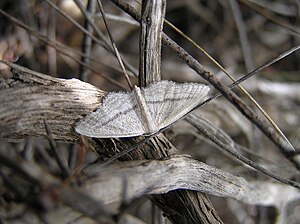Idaea mediaria
| Idaea mediaria | ||||||||||||
|---|---|---|---|---|---|---|---|---|---|---|---|---|

Idaea mediaria |
||||||||||||
| Systematics | ||||||||||||
|
||||||||||||
| Scientific name | ||||||||||||
| Idaea mediaria | ||||||||||||
| ( Huebner , 1819) |
Idaea mediaria is a butterfly ( moth ) fromthe Spanner family (Geometridae).
features
The moths have a wingspan of 14 to 19 mm. The forewings are relatively narrow. The basic color is sandy to light gray, the pattern is dark gray to dark brown and often darkly dusted. The inner transverse line is practically nonexistent or only hinted at, but the central band can be relatively wide and is always very clearly developed. It is almost straight, runs obliquely to the outer transverse line and approaches the outer transverse line towards the costal margin. The outer transverse line, wavy line and hem line are very close together. All three lines are slightly wavy to slightly jagged. Discal spots are mostly present, but not very pronounced. On the forewings they are clearly separated from the central band at the roots, on the hind wings they are close to the central band, but on the side of the band at the root. There are small, black spots on the edges. The forehead is dark brown, the parting whitish and the collar brown. The palps are relatively small and colored black.
Occurrence and habitat
The species has a relatively narrow distribution area. It stretches from southern Portugal, along the coast to the southern tip of Spain, along a 200 km wide strip on the east coast to southern France. It is also found in the Balearic Islands, Corsica and Sardinia and in Tuscany. There are also some very small and completely isolated occurrences in northwest Spain, Morocco and Algeria. The latter two occurrences are assigned to a separate subspecies Idaea mediaria flavidior Rothschild, 1914.
The species is markedly xerothermophilic; i.e., it prefers dry and hot habitats. It occurs in open biotopes, often near the coast and rises to around 1300 m, very rarely up to 1900 m above sea level.
Phenology and way of life
Idaea mediaria is univoltin , i.e. That is, only one generation is formed per year, which flies from the beginning of June to the end of July, rarely also until mid-August. The moths are attracted to artificial light sources.
The caterpillars are extremely slow growing. They are polyphagous and eat withered plant material from various herbaceous plants . So far, the following have been identified as host plants: gorse ( Ulex europaeus ), Euphorbia spinosa and Dorycnium ( legumes ). The breeding was also successful with bird knotweed ( Polygonum ) and common dandelion ( Taraxacum officinale ).
Systematics
The species was first scientifically described in 1819 by Jacob Huebner under the name Geometra mediaria . A distinction is currently made between two subspecies, the nominotypical subspecies Idaea mediaria mediaria (Hübner, 1819) and Idaea mediaria flavidior (Rothschild, 1914).
swell
literature
- Axel Hausmann: The Geometrid moths of Europe, 2nd Sterrhinae. In A. Hausmann (Ed.): The Geometrid Moths of Europe 2. Apollo Books, Stenstrup 2004, ISBN 87-88757-37-4
Web links
- Fauna Europaea systematics and distribution (English)
- www.lepiforum.de Taxonomy and photos
- Moths and Butterflies of Europe and North Africa (English)
- Papillons de Poitou-Charente